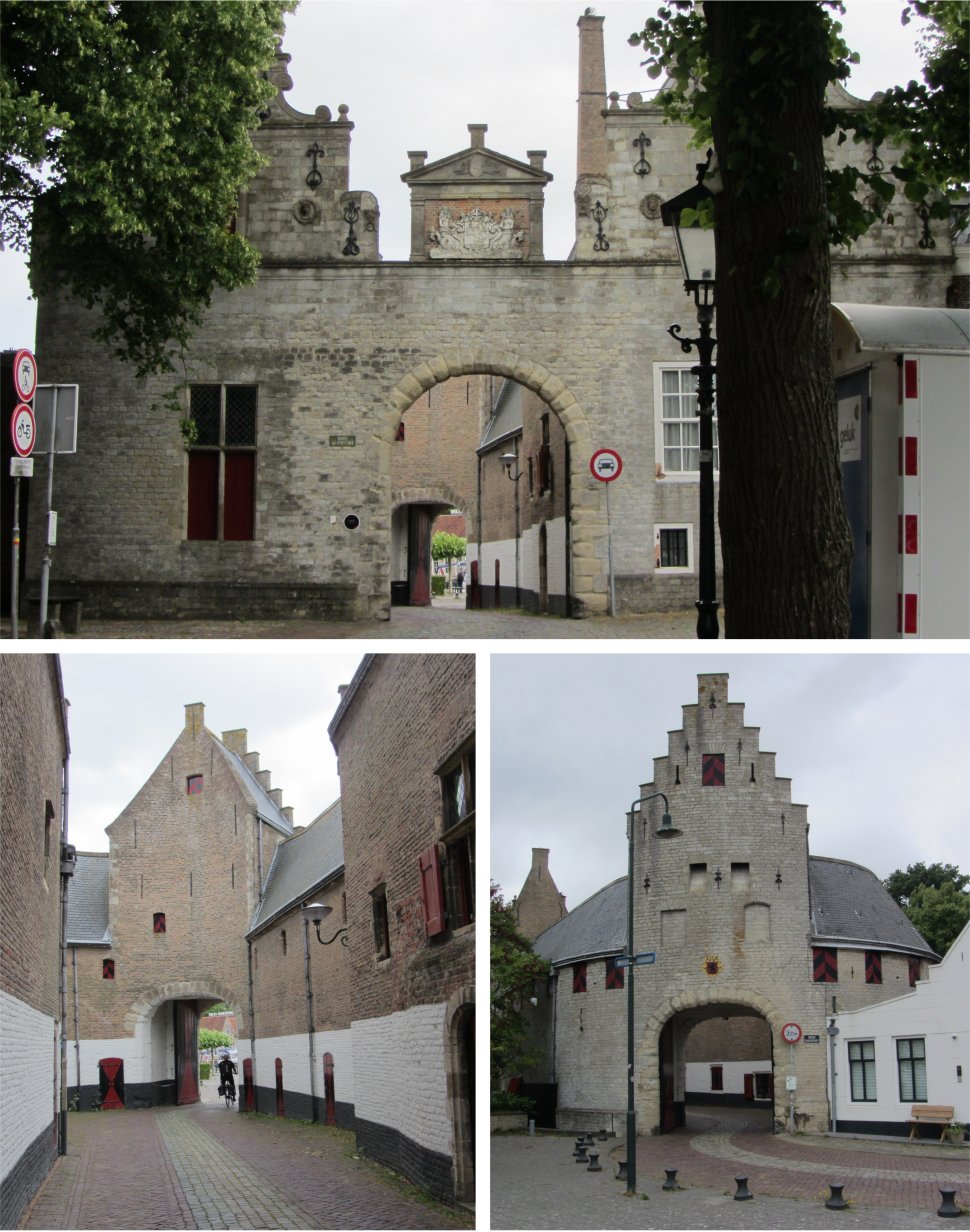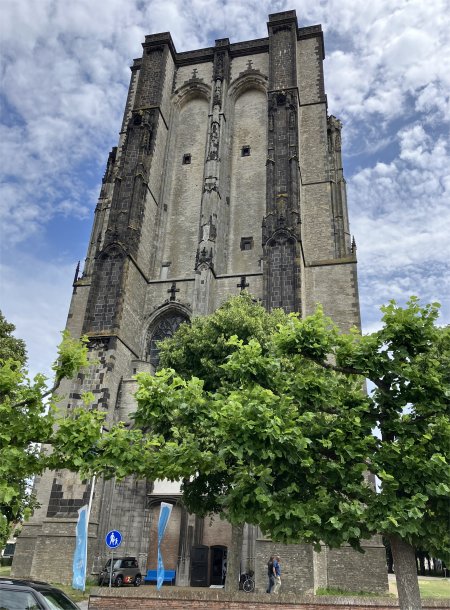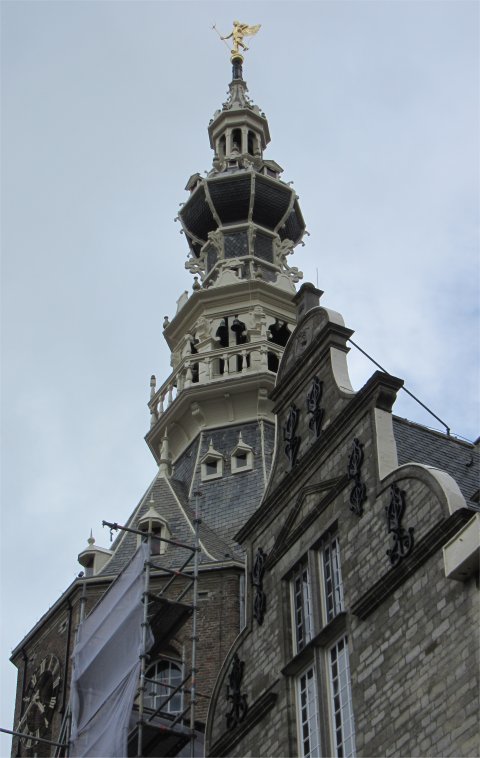 Scrupulously Clean Trawler |
I took a short hike down the dyke to the lock gate, which was probably only ever used to arrest tidal surges, to get a feel of the wind. There were not many walkers or cyclists out today. Looking across to the houses behind the dyke, it was clear that the land was all below sea level; hard to convey in a photograph. But the Dutch are good at protecting their land these days.
When we got our act together, we indulged in a walk around town. Proceeding along the Niuewe Haven, we marvelled at the spotlessly clean trawlers. This section of the town harbour brought us to the Zuidhavenpoort. Zierikzee has largely retained its medieval fortification structure. In the fourteenth century the town was surrounded by a moat and a wall. This wall was reinforced with approximately twenty, mainly semicircular, wall towers. Six gates gave access to the fortress. The Zuidhavenpoort, which served to protect the southern harbour entrance, is one of them.
This sturdy town gate, together with the adjacent Noordhavenpoort, protect the entrance to the harbour. Anyone who approached medieval Zierikzee by ship must have been impressed by the town's defences. The canals, walls and gates made Zierikzee into a strong fortress. Zierikzee still has that character, although the walls and some of the gates have disappeared. Zierikzee is not wrongly called a town like a castle. The two harbour gates originally date from the 14th century. They were later expanded, renovated and embellished. The town had to withstand three heavy sieges at the beginning of the 14th century. To withstand new enemies, the town defences were renewed. These two gates were the result.
 Zuidhavenpoort |
 Ad Braat |
The nearby Noordhavenpoort looks a lot less sturdy than the Zuidhavenpoort. Yet it is obvious to assume that it would originally have had a shape similar to the Zuidhavenpoort.
 Noordhavenpoort |
 Market in Havenplein |
At the top of the Oude Haven, we headed past Kikkerfontein into the beautiful Havenpark and then the Havenplein where today it was adorned with market stalls. We weaved an erratic route up to Nobelpoort, a gate that we had been unable to locate the previous year.
Zierikzee is the only city in the Netherlands to have the great privilege of owning three of its medieval gates, which have remained virtually unchanged from the 16th century. Of these three gates, the Nobelpoort which stands on the north side of the city, is the oldest. This can be determined from the use of Tournai stone in the lower part and the use of Flemish bonding in the brickwork.
The gate dates from the first quarter of the 14th century. After the heavy siege by the Flemish in 1304, the defence was drastically improved, leading to the construction of this gate. The name of the master builder of this gate is unknown, because in 1811 the archive documents were sold by the then mayor as waste paper.
 Nobelpoort |
We headed back down Nobelstraat, passing De Hoop mill which we had also missed the previous year. Today it was largely obscured by scaffolding.
We stopped for coffee and apple pie in Plein Montmartre. In 2012, when old dilapidated warehouses were demolished, new buildings were built, suitable as shops and residential properties. The adjacent parking lot was transformed into an intimate, attractive square, complete with benches and a frog fountain in the middle. Because the square was given a social, cultural and artistic destination, the name Plein Montmartre fits in perfectly and was officially given that name in 2015. In 2014, the artists from the adjacent Beddeweeg created a mural on a blind side wall, after which it became a new attraction. It is now one of the most photographed places in the town.
 Plein Montmartre with Animated Character |
The Reformed Church owner could no longer maintain the Nieuwe Kerk due to the heavy financial burden. The building was closed in 1971, and deteriorated noticeably after windows were smashed and wind and rain were given free rein. A solution came in 1977. The building was transferred to the Old Zeeland Churches Foundation. With financial support, the building was restored in phases in the years 1978-1988. As a beautiful example of 19th century ecclesiastical architecture, the Nieuwe Kerk is a special object in a monumental town such as Zierikzee. The building was festively opened on April 16, 1988.
 Nieuwe Kerk |
 Sint-Lievensmonstertoren aka Dikke Toren (Fat Tower) |
 Stadhuismuseum |
We headed back to Duonita, passing the Stadhuismuseum on the way. Back in the marina we learnt that some old chap had left a shopping bag full of goodies in a restaurant in the Havenplein. Seeing that he was in a fit of desperation, I volunteered to head back to the square and retrieve it for him. The operation was a success, and the old fellow had tears in his eyes when he took repossession.
The restaurant at the marina was packed out in the evening, possibly due to the threat of inclement weather, so we dined back in town. There was much discussion between us regarding wind predictions for the forthcoming week. Linking those with tides, a plan was hatched to take advantage of a weather window. The aim was to cross the Oosterschelde to the Roompot, and head out from there to the North Sea around 5am on the following Sunday. On our return to Duonita the wind had already wound itself up to Force 7.5!
